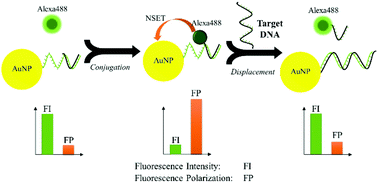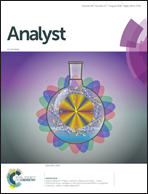Ultrasensitive detection of nucleic acids based on dually enhanced fluorescence polarization†
Abstract
Highly sensitive detection of nucleic acids is crucial for genomics, transcriptomics, and heterogeneity studies. Conventional fluorescence polarization and intensity-based assays for DNA/RNA measurements often suffer from a poor limit of detection and a long test period. A versatile nanoscale probe based on a competitive displacement assay and fluorescence polarization was proposed for the simple, fast and sensitive detection of nucleic acids. For the probe, a partially complementary double-stranded DNA (dsDNA) was used as a connector of gold nanoparticles (AuNPs) and Alexa fluor 488 dyes (Alexa488), leading to the nanometal surface energy transfer (NSET) between Alexa488 and AuNPs. Meanwhile, suppression of the fluorescence intensity caused a decrease in the effective concentration of the Alexa488, and an increase in the volume or mass prolonged the rotational relaxation time of the Alexa488, both of which increased polarization of the Alexa488 in an aqueous solution. After competitive displacement between the probe and the target strand, the decrease in the volume or mass of the Alexa488 and fluorescence recovery resulted in the decline of the fluorescence polarization of the Alexa488, which could be used to sensitively detect the target concentration. After optimization, the fluorescence polarization-based method achieved a pM level detection of single-stranded nucleic acids within 30 minutes.



 Please wait while we load your content...
Please wait while we load your content...